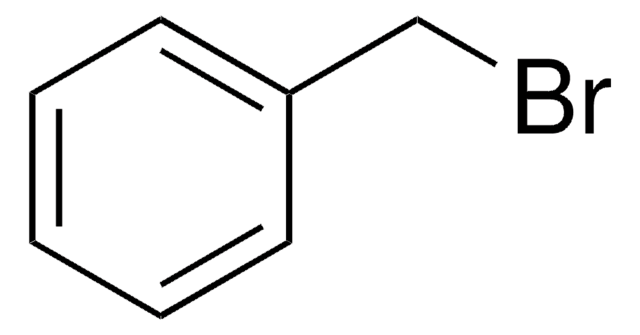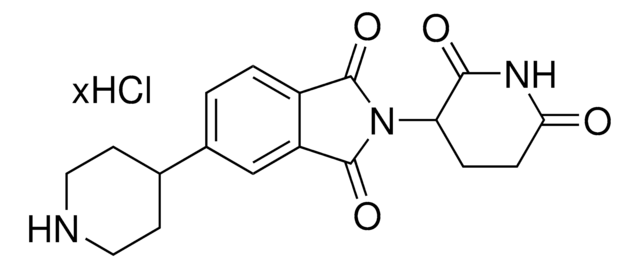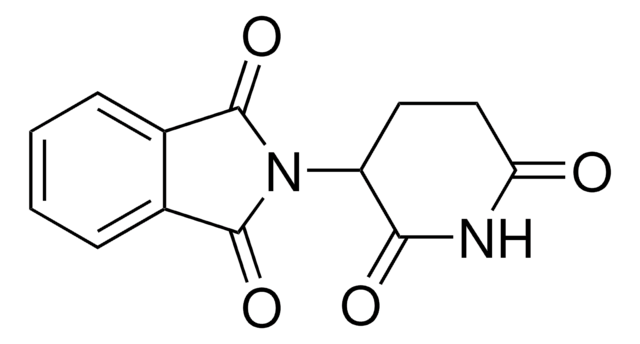930695
4-Aminomethyl-2-(2,6-dioxopiperidin-3-yl)isoindole-1,3-dione hydrochloride
≥95%
동의어(들):
1H-Isoindole-1,3(2H)-dione, 4-(aminomethyl)-2-(2,6-dioxo-3-piperidinyl) hydrochloride
로그인조직 및 계약 가격 보기
모든 사진(1)
About This Item
실험식(Hill 표기법):
C14H13N3O4 · xHCl
CAS Number:
Molecular Weight:
287.27 (free base basis)
MDL number:
UNSPSC 코드:
12352101
NACRES:
NA.26
추천 제품
Quality Level
분석
≥95%
양식
powder
반응 적합성
reagent type: ligand
작용기
amine
저장 온도
2-8°C
SMILES string
NCC1=C(C(N(C2CCC(NC2=O)=O)C3=O)=O)C3=CC=C1
InChI
1S/C14H13N3O4/c15-6-7-2-1-3-8-11(7)14(21)17(13(8)20)9-4-5-10(18)16-12(9)19/h1-3,9H,4-6,15H2,(H,16,18,19)
InChI key
TUMJPYMYNBEMDD-UHFFFAOYSA-N
애플리케이션
4-Aminomethyl-2-(2,6-dioxopiperidin-3-yl)isoindole-1,3-dione hydrochloride is a functionalized Cereblon ligand used for development of protein degrader building blocks. Contains a terminal amine group, allowing rapid conjugation of carboxyl containing linkers. A basic building block for development of a protein degrader library.
기타 정보
Targeted Protein Degradation by Small Molecules
Destruction of DNA-Binding Proteins by Programmable Oligonucleotide PROTAC (O′PROTAC): Effective Targeting of LEF1 and ERG
Small-Molecule PROTACS: New Approaches to Protein Degradation
Targeted Protein Degradation: from Chemical Biology to Drug Discovery
Impact of linker length on the activity of PROTACs
Destruction of DNA-Binding Proteins by Programmable Oligonucleotide PROTAC (O′PROTAC): Effective Targeting of LEF1 and ERG
Small-Molecule PROTACS: New Approaches to Protein Degradation
Targeted Protein Degradation: from Chemical Biology to Drug Discovery
Impact of linker length on the activity of PROTACs
Technology Spotlight: Degrader Building Blocks for Targeted Protein Degradation
Protein Degrader Building Blocks
Protein Degrader Building Blocks
법적 정보
PROTAC® is a registered trademark of Arvinas Operations, Inc., and is used under license.
PROTAC is a registered trademark of Arvinas Operations, Inc., and is used under license
신호어
Danger
유해 및 위험 성명서
Hazard Classifications
Repr. 1B
Storage Class Code
6.1C - Combustible acute toxic Cat.3 / toxic compounds or compounds which causing chronic effects
WGK
WGK 3
가장 최신 버전 중 하나를 선택하세요:
Daniel P Bondeson et al.
Annual review of pharmacology and toxicology, 57, 107-123 (2016-10-13)
Protein homeostasis networks are highly regulated systems responsible for maintaining the health and productivity of cells. Whereas therapeutics have been developed to disrupt protein homeostasis, more recently identified techniques have been used to repurpose homeostatic networks to effect degradation of
자사의 과학자팀은 생명 과학, 재료 과학, 화학 합성, 크로마토그래피, 분석 및 기타 많은 영역을 포함한 모든 과학 분야에 경험이 있습니다..
고객지원팀으로 연락바랍니다.







![[1,1′-Bis(diphenylphosphino)ferrocene]dichloropalladium(II)](/deepweb/assets/sigmaaldrich/product/structures/130/734/8846aa26-1858-458a-998d-8c306c13bf0f/640/8846aa26-1858-458a-998d-8c306c13bf0f.png)

